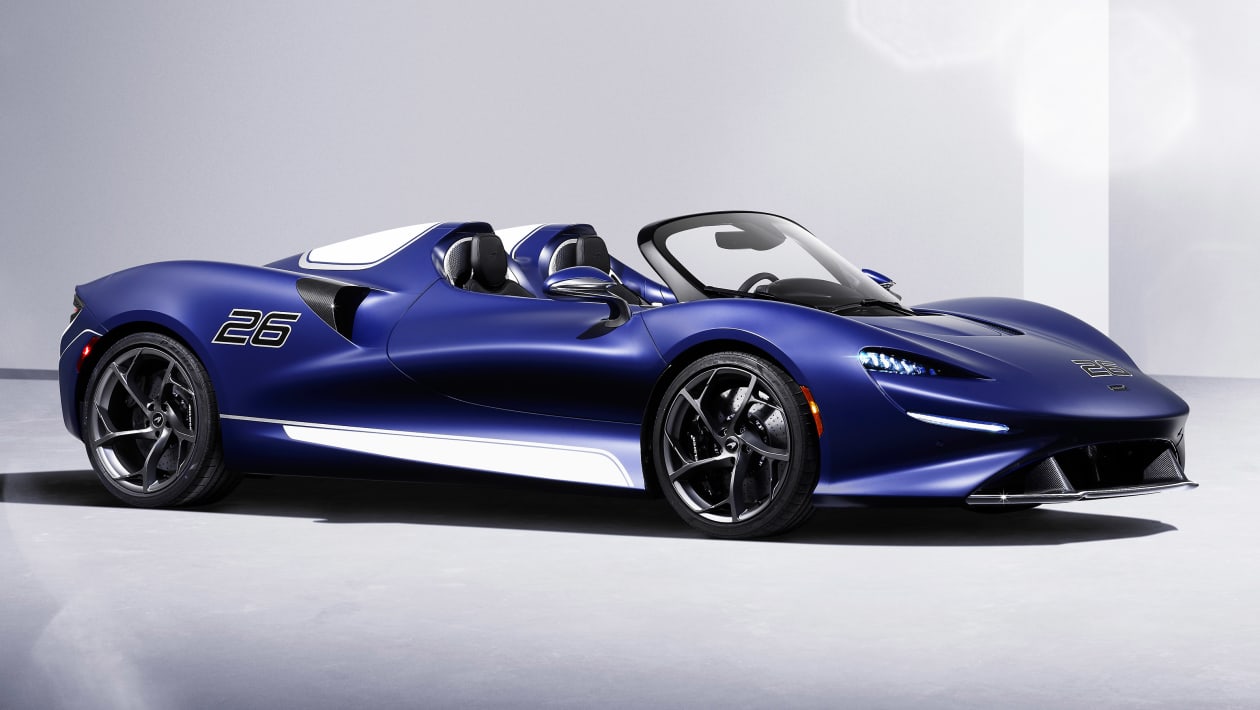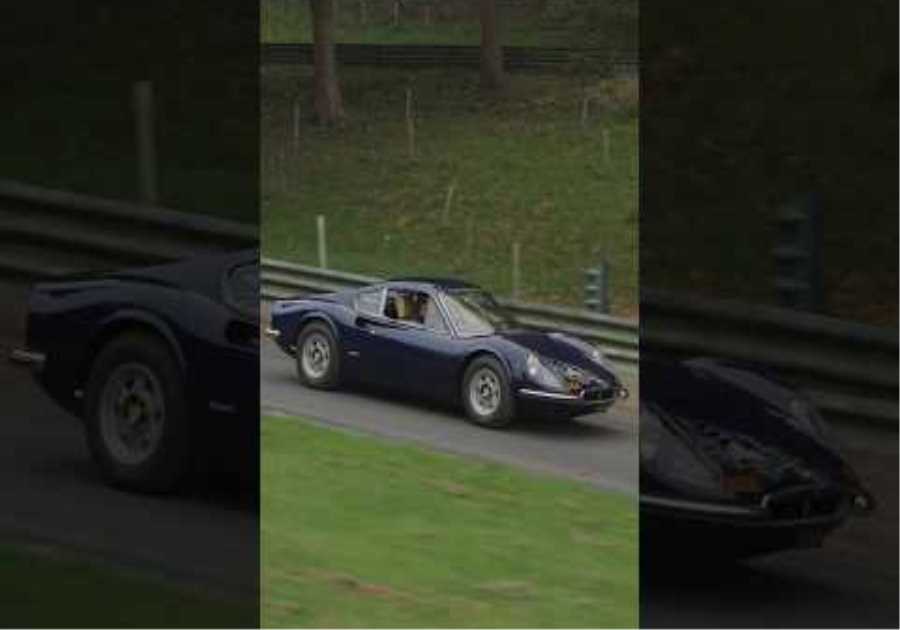
McLaren has announced more details on the optional windshield on its Elva open-top Speedster, a component that is compliant in some states and that will greatly improve everyday usability for owners. This first model was unveiled in a historic Satin Casa Blue, with customer car deliveries scheduled to begin in late 2021.
Equipped with windshields, the Elva not only makes it more user-friendly on the road, it also dispenses with the standard car’s Active Air Management System. Thanks to the light glass and the carbon frame, the total weight only increases by 20 kg. This despite the use of windshield wipers with rain sensors, washer nozzles, sun visors and heated glass.
The Elva remains otherwise unchanged and still does not have a roof, side windows or a rear window for the full Speedster experience.
> First Lanzante LM 25 Edition delivered – conversion references McLaren F1 GTR-1R
The company also tacitly announced a second reduction in Elva production numbers, reducing the number from 249 to a total of 149 – a reduction of 250 units compared to the originally planned production of 399. It combines the P1, Senna and the aforementioned Speedtail in McLaren’s Ultimate series, which surpasses the contemporary McLaren range. The Elva’s name is derived from Bruce McLaren’s exploits in customer sports car racing in the 1970s when Elva manufactured and supported a customer racing version of McLaren’s dominant M1A.
The main technical ingredients are known, but where the Senna was designed for the racetrack and the Speedtail was designed for top speed, the Elva was specifically designed for the open road – presumably on a sunny day.
Production is already running. The first deliveries of vehicles with windshields are planned for the end of 2021.
What is the Active Air Management System?
In simple terms, it consists of a carbon fiber plate in the front hood that opens at a certain speed. This exposes a vent that is supplied with air from an inlet in the front manifold, and that air is then directed up and over and around the cockpit, creating an air bubble for the occupants. At lower speeds, when the vents are closed, the air is instead directed to the radiators in the front of the car. It’s not the most aesthetic solution, but it works.
How is it from the passenger seat?
When the system is not in use, driving the Elva at 30 mph and below is like a Caterham with no built-in doors, with air swirling your ears, filling your nostrils, and giving your tear ducts a workout. At 80 km / h it is as uncomfortable as you would imagine a 80 km / h headwind without protection. And at 100 km / h, you’re not sure which will happen first – whether your head is torn from your shoulders or your eyeballs pushed through the back of your head.
When AAM is active, 30 mph will feel like you’ve opened the sunroof on a sedan at 70 mph, 50 mph is more comfortable than lowering the roof at three-digit speeds in a Porsche Boxster, and at 70 Miles per hour you can still have a conversation with the driver. And while the flap makes itself felt when triggered, it’s not a distraction blocking your field of vision.
Powertrain and chassis
The drive of the Elva is the latest development of the 4-liter twin-turbo V8 of the Senna GTR. With a new exhaust system, McLaren calls the Nirvana system, which increases the peak output from 789 hp to 804 hp. The system has a total of four exhaust outlets, two of which are located in the rear mesh between the taillights and two more are located on the front edge of the rear deck in the active rear wing. The need for the two forms of exhaust outlet is for acoustical reasons as well as for performance reasons, since the top two are designed to reproduce a higher frequency note that can be heard more acutely in the cabin.
The networked hydraulic suspension of the 720S is installed as well as the latest 390 mm carbon-ceramic brakes and new titanium calipers. And while McLaren has not confirmed any weight for the Elva, they say it will be the lightest McLaren road car – with the exception of the F1 – so expect it to be under 1198 kg dry weight. From a dynamic perspective, the Elva was designed to be somewhere between the Speedtail and Senna in terms of dynamics. It’s more agile and focused than the GT-like Speedtail, but far less aggressive than the Senna.
This is reflected in the Elva’s aerodynamics package, which results in far less downforce than the Senna, not to mention the Super Series and Sports Series McLarens like the 720S and 600LT. With higher horsepower and lighter weight, the Elva’s handling balance has been a huge challenge for chassis engineers, who have put considerable effort into making sure the Elva’s handling remains progressive and harmless – or as good as an 804bhp rear end. Wheel drive supercar might be realistic.
design
Rob Melville, Director of Design Mclaren, not only gave the Ultimate Series Mclaren buyers a new model to revamp or flip, but also confirmed that this indicates McLaren’s ever-evolving design language that will be applied to future models. The practical reality of not having to worry about the side window and windshield, of course, gave Melville and his team an extremely far-reaching mandate to bring the Elva design to a level that would otherwise be impossible with McLaren’s mainstream offerings.
The body-facing surface, for example, is incredibly deep and was designed to mimic the sidepod of an F1 car. Inside this volume is a hidden inlet tunnel, an element McLaren first used on its P1. The air enters through a small inlet next to the door mirror. This allows clean, cool air to flow into the lower half of the side-mounted radiator, while a more traditional external inlet at the rear rear draws air to the upper half.
As with many McLarens, the rear is mostly open to let out the intense heat generated by the engine and exhaust system. Instead of an open mesh, the rear fairing is made of laser-cut aluminum, which integrates a new design of almond-shaped rear light units as well as the two lower exhaust outlets and the rear diffuser.
In the open cabin, the Elva also features a number of new key interior elements that may be featured on future McLaren models, including a free-standing HMI screen, instrument panel and center console. Elements that were specially developed for use in a purely open cabin, such as the low-set ventilation slots and loudspeaker integration, are specific to the Elva.
The storage space is understandably slim, although a tailgate just behind the cab is specially designed for two full-face helmets that are sold with the car for owners who need some extra protection at high speeds.
Find out more about the next round of evo Track Days on our hub page …
The post McLaren Elva now available with windshield – total production reduced to just 149 units first appeared on monter-une-startup.






